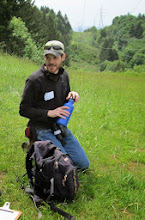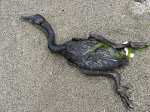
These species nest during the winter and spring in southern California and Mexico. They spend their summers and fall with us in the north where we usually see them flying over the water. Surprisingly, they stood on the beach and allowed us to walk right by them as we searched for birds.
We only found a few birds, much fewer than last month, and the most iteresting was an intact black oystercatcher.
 We occasionally see these guys hunting invertebrates on intertidal rocks, but we have never seen one this close. Though oystercatchers are large shorebirds, they look like they were constructed with leftover parts of woodpeckers, crows, and chickens.
We occasionally see these guys hunting invertebrates on intertidal rocks, but we have never seen one this close. Though oystercatchers are large shorebirds, they look like they were constructed with leftover parts of woodpeckers, crows, and chickens. The chicken-like feet had thick nails, used to cling to slippery, waver-battered rocks.
The chicken-like feet had thick nails, used to cling to slippery, waver-battered rocks.
The beautiful orange bill was abraded from prying snails and limpets out of their nooks and crannies. I could have stayed and admired the oystercatcher for much longer, but we had to move on.
After the survey, we drove to the Nestucca River National Wildlife Refuge. The refuge has been around for a few year, but a portion was opened to the public last week.

The refuge was established to provide winter habitat for rare subspecies of Canada and cackling geese, but they had not arrived yet, so we enjoyed the views from the top of the hill.







No comments:
Post a Comment